SITXHRM002 Roster Staff - Desklib
VerifiedAdded on 2023/06/07
|9
|1551
|251
AI Summary
This study material covers award provisions, leave entitlements, and rostering records in the hospitality industry. It also provides insights on social and cultural skill mix and religious accommodations in roster preparation. The content is relevant to SITXHRM002 Roster Staff course under leisure management.
Contribute Materials
Your contribution can guide someone’s learning journey. Share your
documents today.
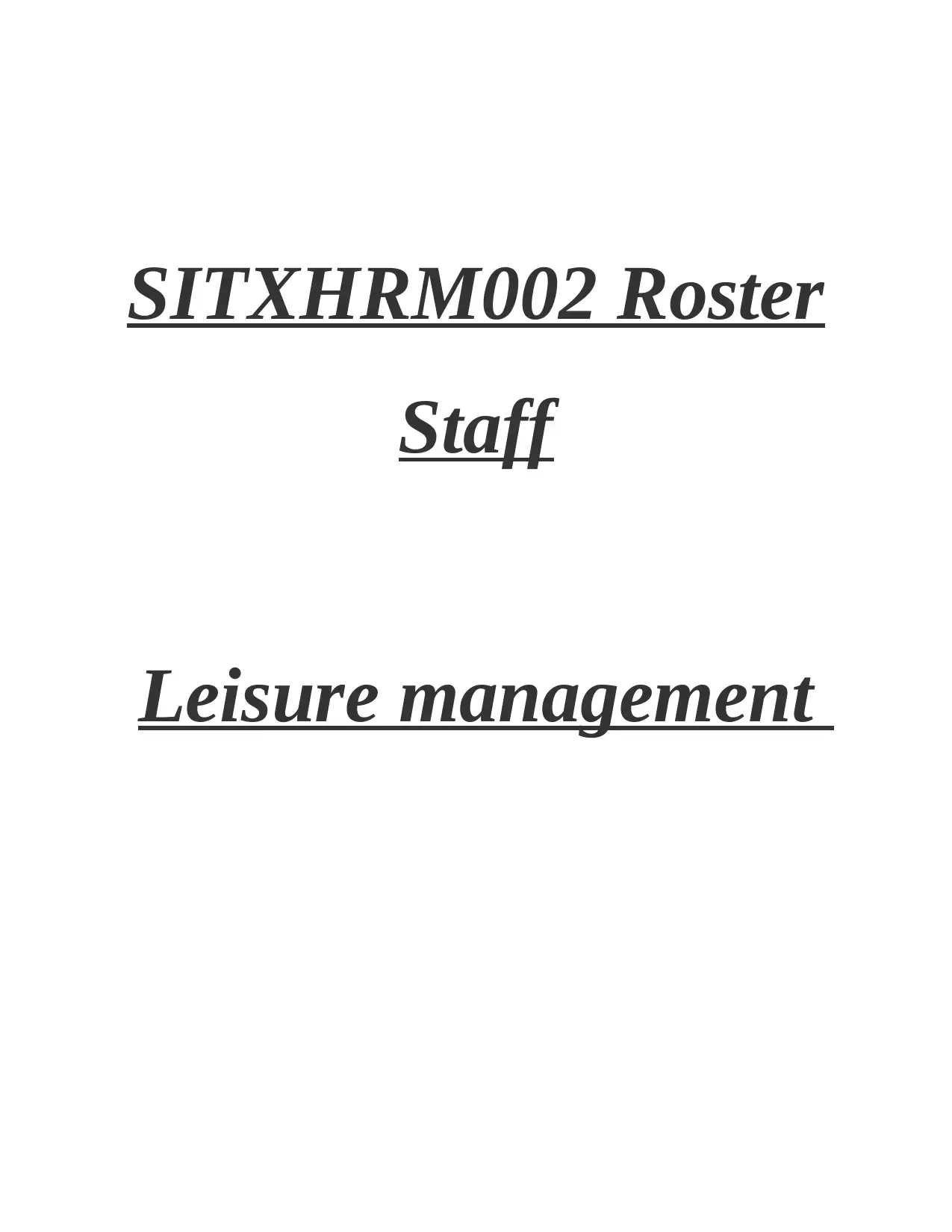
SITXHRM002 Roster
Staff
Leisure management
Staff
Leisure management
Secure Best Marks with AI Grader
Need help grading? Try our AI Grader for instant feedback on your assignments.
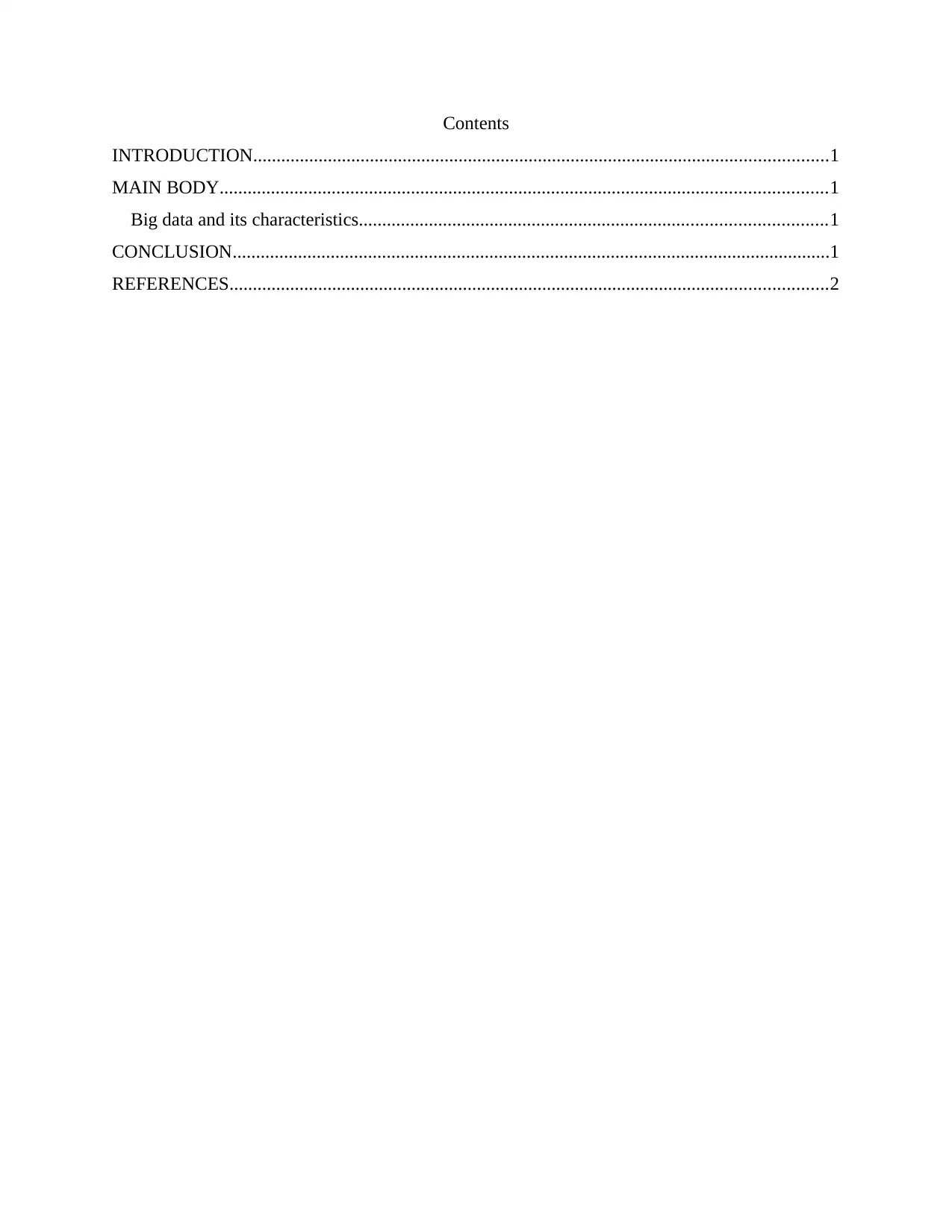
Contents
INTRODUCTION...........................................................................................................................1
MAIN BODY..................................................................................................................................1
Big data and its characteristics....................................................................................................1
CONCLUSION................................................................................................................................1
REFERENCES................................................................................................................................2
INTRODUCTION...........................................................................................................................1
MAIN BODY..................................................................................................................................1
Big data and its characteristics....................................................................................................1
CONCLUSION................................................................................................................................1
REFERENCES................................................................................................................................2
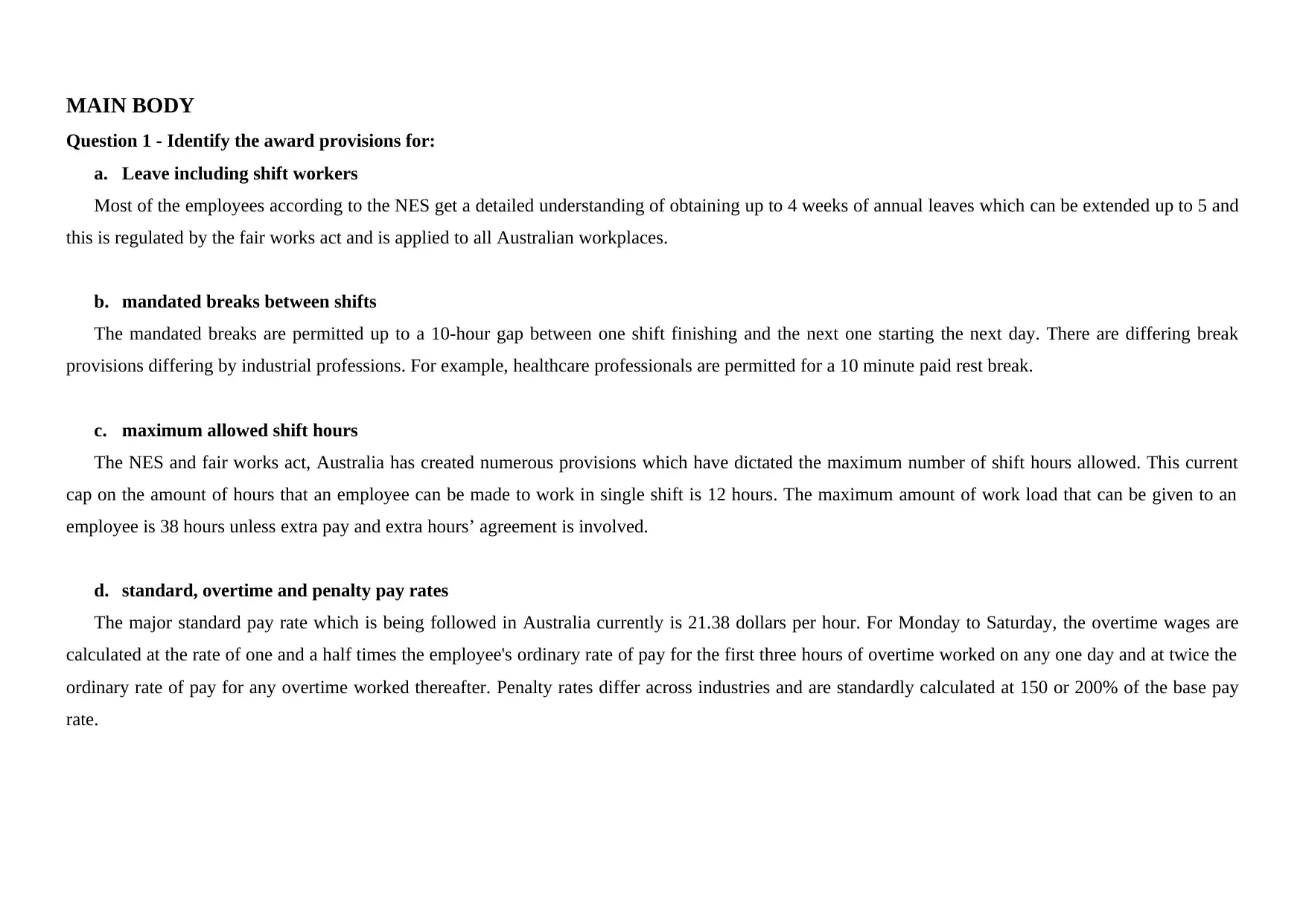
MAIN BODY
Question 1 - Identify the award provisions for:
a. Leave including shift workers
Most of the employees according to the NES get a detailed understanding of obtaining up to 4 weeks of annual leaves which can be extended up to 5 and
this is regulated by the fair works act and is applied to all Australian workplaces.
b. mandated breaks between shifts
The mandated breaks are permitted up to a 10-hour gap between one shift finishing and the next one starting the next day. There are differing break
provisions differing by industrial professions. For example, healthcare professionals are permitted for a 10 minute paid rest break.
c. maximum allowed shift hours
The NES and fair works act, Australia has created numerous provisions which have dictated the maximum number of shift hours allowed. This current
cap on the amount of hours that an employee can be made to work in single shift is 12 hours. The maximum amount of work load that can be given to an
employee is 38 hours unless extra pay and extra hours’ agreement is involved.
d. standard, overtime and penalty pay rates
The major standard pay rate which is being followed in Australia currently is 21.38 dollars per hour. For Monday to Saturday, the overtime wages are
calculated at the rate of one and a half times the employee's ordinary rate of pay for the first three hours of overtime worked on any one day and at twice the
ordinary rate of pay for any overtime worked thereafter. Penalty rates differ across industries and are standardly calculated at 150 or 200% of the base pay
rate.
Question 1 - Identify the award provisions for:
a. Leave including shift workers
Most of the employees according to the NES get a detailed understanding of obtaining up to 4 weeks of annual leaves which can be extended up to 5 and
this is regulated by the fair works act and is applied to all Australian workplaces.
b. mandated breaks between shifts
The mandated breaks are permitted up to a 10-hour gap between one shift finishing and the next one starting the next day. There are differing break
provisions differing by industrial professions. For example, healthcare professionals are permitted for a 10 minute paid rest break.
c. maximum allowed shift hours
The NES and fair works act, Australia has created numerous provisions which have dictated the maximum number of shift hours allowed. This current
cap on the amount of hours that an employee can be made to work in single shift is 12 hours. The maximum amount of work load that can be given to an
employee is 38 hours unless extra pay and extra hours’ agreement is involved.
d. standard, overtime and penalty pay rates
The major standard pay rate which is being followed in Australia currently is 21.38 dollars per hour. For Monday to Saturday, the overtime wages are
calculated at the rate of one and a half times the employee's ordinary rate of pay for the first three hours of overtime worked on any one day and at twice the
ordinary rate of pay for any overtime worked thereafter. Penalty rates differ across industries and are standardly calculated at 150 or 200% of the base pay
rate.
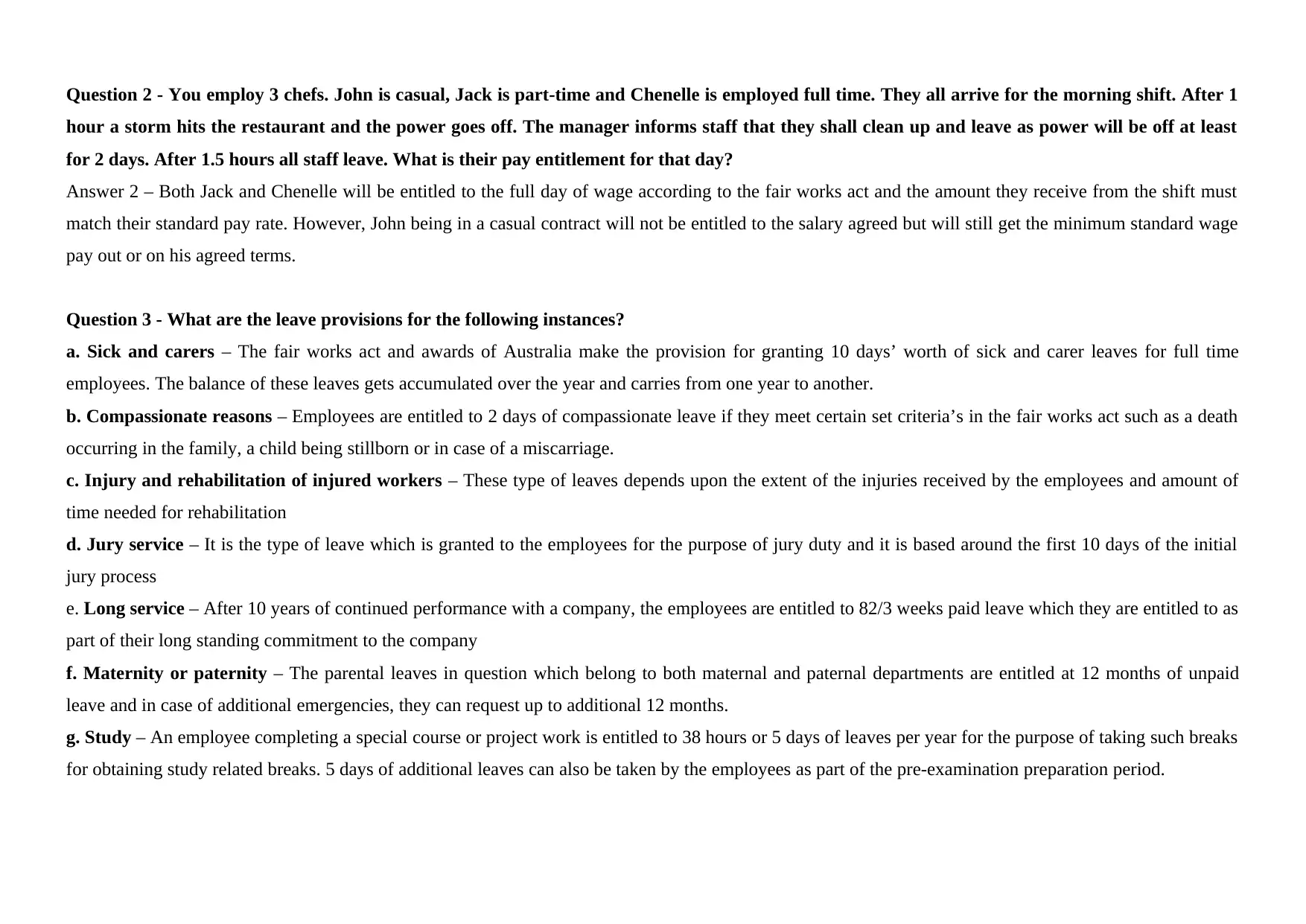
Question 2 - You employ 3 chefs. John is casual, Jack is part-time and Chenelle is employed full time. They all arrive for the morning shift. After 1
hour a storm hits the restaurant and the power goes off. The manager informs staff that they shall clean up and leave as power will be off at least
for 2 days. After 1.5 hours all staff leave. What is their pay entitlement for that day?
Answer 2 – Both Jack and Chenelle will be entitled to the full day of wage according to the fair works act and the amount they receive from the shift must
match their standard pay rate. However, John being in a casual contract will not be entitled to the salary agreed but will still get the minimum standard wage
pay out or on his agreed terms.
Question 3 - What are the leave provisions for the following instances?
a. Sick and carers – The fair works act and awards of Australia make the provision for granting 10 days’ worth of sick and carer leaves for full time
employees. The balance of these leaves gets accumulated over the year and carries from one year to another.
b. Compassionate reasons – Employees are entitled to 2 days of compassionate leave if they meet certain set criteria’s in the fair works act such as a death
occurring in the family, a child being stillborn or in case of a miscarriage.
c. Injury and rehabilitation of injured workers – These type of leaves depends upon the extent of the injuries received by the employees and amount of
time needed for rehabilitation
d. Jury service – It is the type of leave which is granted to the employees for the purpose of jury duty and it is based around the first 10 days of the initial
jury process
e. Long service – After 10 years of continued performance with a company, the employees are entitled to 82/3 weeks paid leave which they are entitled to as
part of their long standing commitment to the company
f. Maternity or paternity – The parental leaves in question which belong to both maternal and paternal departments are entitled at 12 months of unpaid
leave and in case of additional emergencies, they can request up to additional 12 months.
g. Study – An employee completing a special course or project work is entitled to 38 hours or 5 days of leaves per year for the purpose of taking such breaks
for obtaining study related breaks. 5 days of additional leaves can also be taken by the employees as part of the pre-examination preparation period.
hour a storm hits the restaurant and the power goes off. The manager informs staff that they shall clean up and leave as power will be off at least
for 2 days. After 1.5 hours all staff leave. What is their pay entitlement for that day?
Answer 2 – Both Jack and Chenelle will be entitled to the full day of wage according to the fair works act and the amount they receive from the shift must
match their standard pay rate. However, John being in a casual contract will not be entitled to the salary agreed but will still get the minimum standard wage
pay out or on his agreed terms.
Question 3 - What are the leave provisions for the following instances?
a. Sick and carers – The fair works act and awards of Australia make the provision for granting 10 days’ worth of sick and carer leaves for full time
employees. The balance of these leaves gets accumulated over the year and carries from one year to another.
b. Compassionate reasons – Employees are entitled to 2 days of compassionate leave if they meet certain set criteria’s in the fair works act such as a death
occurring in the family, a child being stillborn or in case of a miscarriage.
c. Injury and rehabilitation of injured workers – These type of leaves depends upon the extent of the injuries received by the employees and amount of
time needed for rehabilitation
d. Jury service – It is the type of leave which is granted to the employees for the purpose of jury duty and it is based around the first 10 days of the initial
jury process
e. Long service – After 10 years of continued performance with a company, the employees are entitled to 82/3 weeks paid leave which they are entitled to as
part of their long standing commitment to the company
f. Maternity or paternity – The parental leaves in question which belong to both maternal and paternal departments are entitled at 12 months of unpaid
leave and in case of additional emergencies, they can request up to additional 12 months.
g. Study – An employee completing a special course or project work is entitled to 38 hours or 5 days of leaves per year for the purpose of taking such breaks
for obtaining study related breaks. 5 days of additional leaves can also be taken by the employees as part of the pre-examination preparation period.
Secure Best Marks with AI Grader
Need help grading? Try our AI Grader for instant feedback on your assignments.
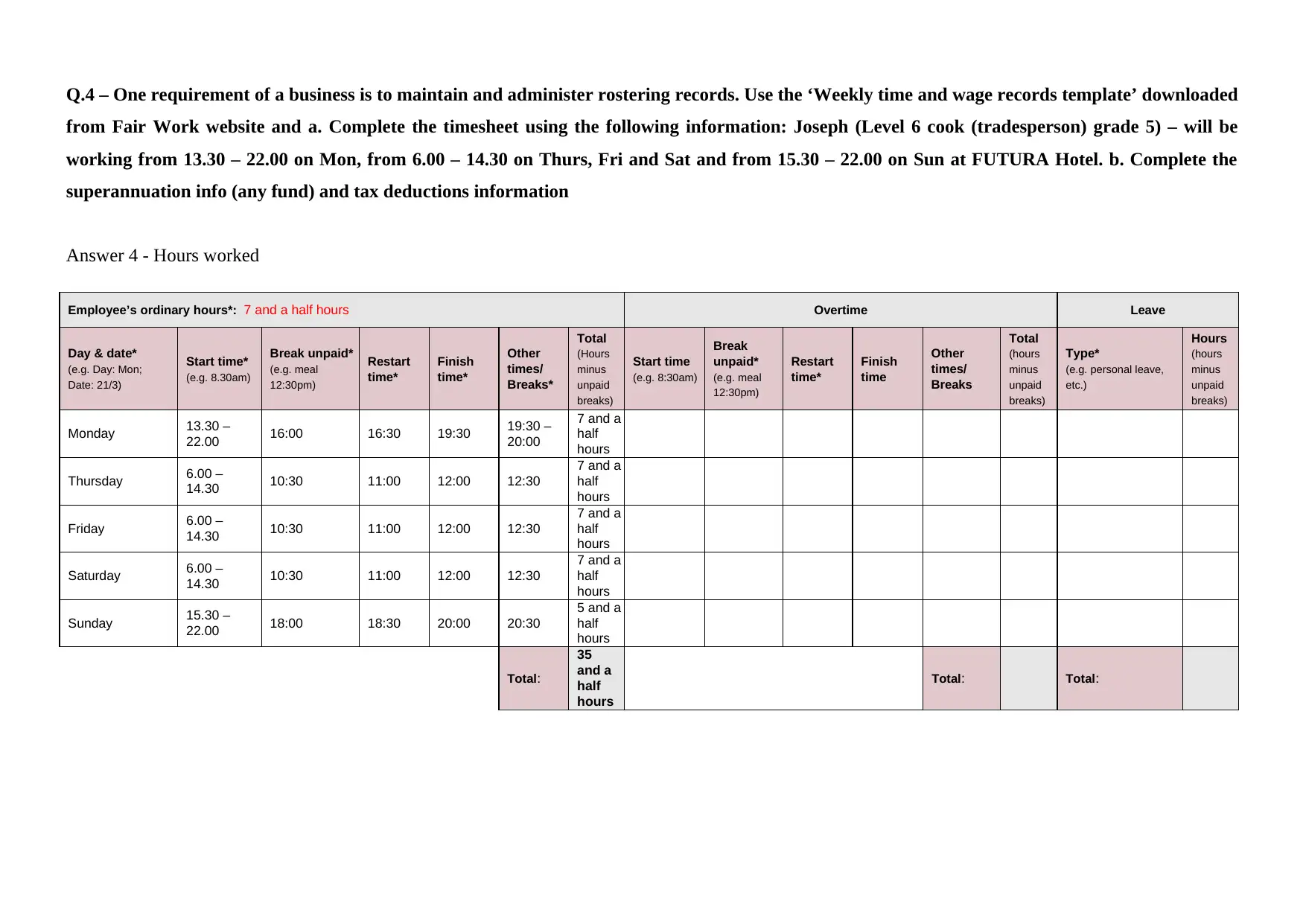
Q.4 – One requirement of a business is to maintain and administer rostering records. Use the ‘Weekly time and wage records template’ downloaded
from Fair Work website and a. Complete the timesheet using the following information: Joseph (Level 6 cook (tradesperson) grade 5) – will be
working from 13.30 – 22.00 on Mon, from 6.00 – 14.30 on Thurs, Fri and Sat and from 15.30 – 22.00 on Sun at FUTURA Hotel. b. Complete the
superannuation info (any fund) and tax deductions information
Answer 4 - Hours worked
Employee’s ordinary hours*: 7 and a half hours Overtime Leave
Day & date*
(e.g. Day: Mon;
Date: 21/3)
Start time*
(e.g. 8.30am)
Break unpaid*
(e.g. meal
12:30pm)
Restart
time*
Finish
time*
Other
times/
Breaks*
Total
(Hours
minus
unpaid
breaks)
Start time
(e.g. 8:30am)
Break
unpaid*
(e.g. meal
12:30pm)
Restart
time*
Finish
time
Other
times/
Breaks
Total
(hours
minus
unpaid
breaks)
Type*
(e.g. personal leave,
etc.)
Hours
(hours
minus
unpaid
breaks)
Monday 13.30 –
22.00 16:00 16:30 19:30 19:30 –
20:00
7 and a
half
hours
Thursday 6.00 –
14.30 10:30 11:00 12:00 12:30
7 and a
half
hours
Friday 6.00 –
14.30 10:30 11:00 12:00 12:30
7 and a
half
hours
Saturday 6.00 –
14.30 10:30 11:00 12:00 12:30
7 and a
half
hours
Sunday 15.30 –
22.00 18:00 18:30 20:00 20:30
5 and a
half
hours
Total:
35
and a
half
hours
Total: Total:
from Fair Work website and a. Complete the timesheet using the following information: Joseph (Level 6 cook (tradesperson) grade 5) – will be
working from 13.30 – 22.00 on Mon, from 6.00 – 14.30 on Thurs, Fri and Sat and from 15.30 – 22.00 on Sun at FUTURA Hotel. b. Complete the
superannuation info (any fund) and tax deductions information
Answer 4 - Hours worked
Employee’s ordinary hours*: 7 and a half hours Overtime Leave
Day & date*
(e.g. Day: Mon;
Date: 21/3)
Start time*
(e.g. 8.30am)
Break unpaid*
(e.g. meal
12:30pm)
Restart
time*
Finish
time*
Other
times/
Breaks*
Total
(Hours
minus
unpaid
breaks)
Start time
(e.g. 8:30am)
Break
unpaid*
(e.g. meal
12:30pm)
Restart
time*
Finish
time
Other
times/
Breaks
Total
(hours
minus
unpaid
breaks)
Type*
(e.g. personal leave,
etc.)
Hours
(hours
minus
unpaid
breaks)
Monday 13.30 –
22.00 16:00 16:30 19:30 19:30 –
20:00
7 and a
half
hours
Thursday 6.00 –
14.30 10:30 11:00 12:00 12:30
7 and a
half
hours
Friday 6.00 –
14.30 10:30 11:00 12:00 12:30
7 and a
half
hours
Saturday 6.00 –
14.30 10:30 11:00 12:00 12:30
7 and a
half
hours
Sunday 15.30 –
22.00 18:00 18:30 20:00 20:30
5 and a
half
hours
Total:
35
and a
half
hours
Total: Total:

Calculation schedules
Deductions
Taxation $0,000.00 Superannuation contribution $0,000.00
Other – type
(e.g. voluntary superannuation contributions) $0,000.00 Number or name and number of super fund:
Other: $0,000.00 Where the entitlement comes from (why the employer is liable to pay it) :
Other: $0,000.00 Period over which contributions
were made:
/ / to
/ /
Total deductions $0,000.00
Date paid into fund: / /
Note: Any election made by the employee in relation to the fund
into which superannuation contributions are to be made must be
kept, along with a record of the date of the election.
Net pay $0,000.00
Q.5 - What are the requirements for time and wage records? How long does these records
must be kept?
1
Deductions
Taxation $0,000.00 Superannuation contribution $0,000.00
Other – type
(e.g. voluntary superannuation contributions) $0,000.00 Number or name and number of super fund:
Other: $0,000.00 Where the entitlement comes from (why the employer is liable to pay it) :
Other: $0,000.00 Period over which contributions
were made:
/ / to
/ /
Total deductions $0,000.00
Date paid into fund: / /
Note: Any election made by the employee in relation to the fund
into which superannuation contributions are to be made must be
kept, along with a record of the date of the election.
Net pay $0,000.00
Q.5 - What are the requirements for time and wage records? How long does these records
must be kept?
1
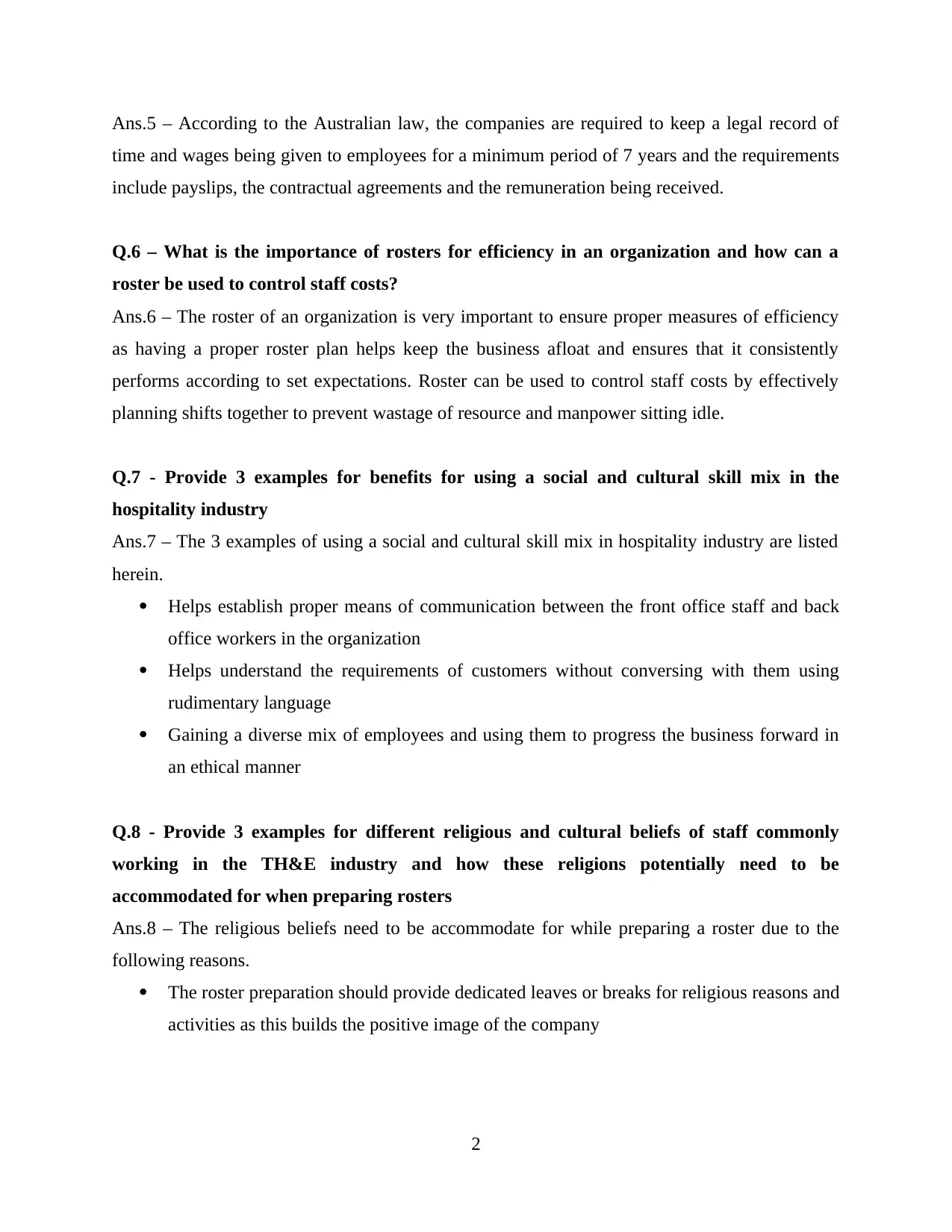
Ans.5 – According to the Australian law, the companies are required to keep a legal record of
time and wages being given to employees for a minimum period of 7 years and the requirements
include payslips, the contractual agreements and the remuneration being received.
Q.6 – What is the importance of rosters for efficiency in an organization and how can a
roster be used to control staff costs?
Ans.6 – The roster of an organization is very important to ensure proper measures of efficiency
as having a proper roster plan helps keep the business afloat and ensures that it consistently
performs according to set expectations. Roster can be used to control staff costs by effectively
planning shifts together to prevent wastage of resource and manpower sitting idle.
Q.7 - Provide 3 examples for benefits for using a social and cultural skill mix in the
hospitality industry
Ans.7 – The 3 examples of using a social and cultural skill mix in hospitality industry are listed
herein.
Helps establish proper means of communication between the front office staff and back
office workers in the organization
Helps understand the requirements of customers without conversing with them using
rudimentary language
Gaining a diverse mix of employees and using them to progress the business forward in
an ethical manner
Q.8 - Provide 3 examples for different religious and cultural beliefs of staff commonly
working in the TH&E industry and how these religions potentially need to be
accommodated for when preparing rosters
Ans.8 – The religious beliefs need to be accommodate for while preparing a roster due to the
following reasons.
The roster preparation should provide dedicated leaves or breaks for religious reasons and
activities as this builds the positive image of the company
2
time and wages being given to employees for a minimum period of 7 years and the requirements
include payslips, the contractual agreements and the remuneration being received.
Q.6 – What is the importance of rosters for efficiency in an organization and how can a
roster be used to control staff costs?
Ans.6 – The roster of an organization is very important to ensure proper measures of efficiency
as having a proper roster plan helps keep the business afloat and ensures that it consistently
performs according to set expectations. Roster can be used to control staff costs by effectively
planning shifts together to prevent wastage of resource and manpower sitting idle.
Q.7 - Provide 3 examples for benefits for using a social and cultural skill mix in the
hospitality industry
Ans.7 – The 3 examples of using a social and cultural skill mix in hospitality industry are listed
herein.
Helps establish proper means of communication between the front office staff and back
office workers in the organization
Helps understand the requirements of customers without conversing with them using
rudimentary language
Gaining a diverse mix of employees and using them to progress the business forward in
an ethical manner
Q.8 - Provide 3 examples for different religious and cultural beliefs of staff commonly
working in the TH&E industry and how these religions potentially need to be
accommodated for when preparing rosters
Ans.8 – The religious beliefs need to be accommodate for while preparing a roster due to the
following reasons.
The roster preparation should provide dedicated leaves or breaks for religious reasons and
activities as this builds the positive image of the company
2
Paraphrase This Document
Need a fresh take? Get an instant paraphrase of this document with our AI Paraphraser
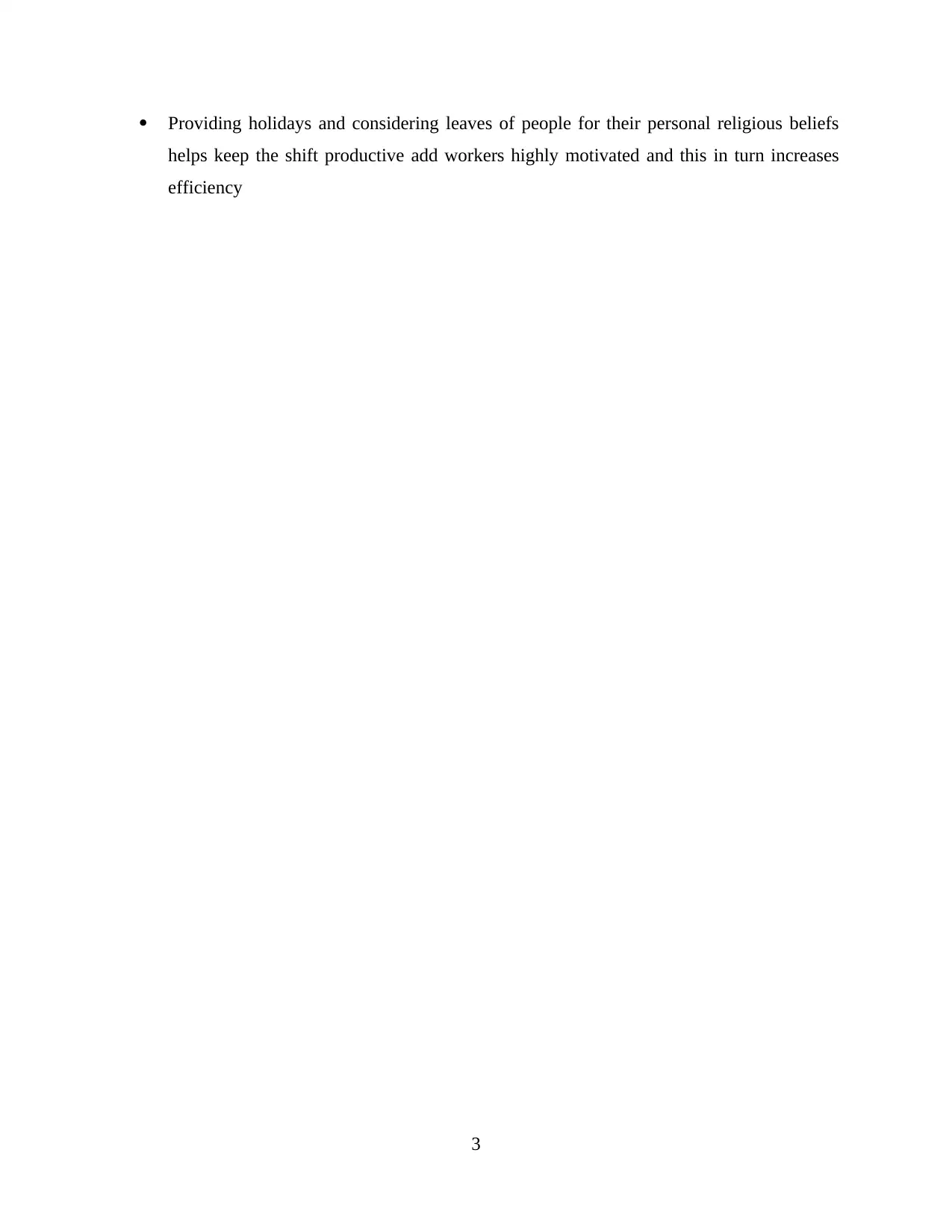
Providing holidays and considering leaves of people for their personal religious beliefs
helps keep the shift productive add workers highly motivated and this in turn increases
efficiency
3
helps keep the shift productive add workers highly motivated and this in turn increases
efficiency
3

REFERENCES
Books and Journals:
4
Books and Journals:
4
1 out of 9
Related Documents
Your All-in-One AI-Powered Toolkit for Academic Success.
+13062052269
info@desklib.com
Available 24*7 on WhatsApp / Email
![[object Object]](/_next/static/media/star-bottom.7253800d.svg)
Unlock your academic potential
© 2024 | Zucol Services PVT LTD | All rights reserved.





